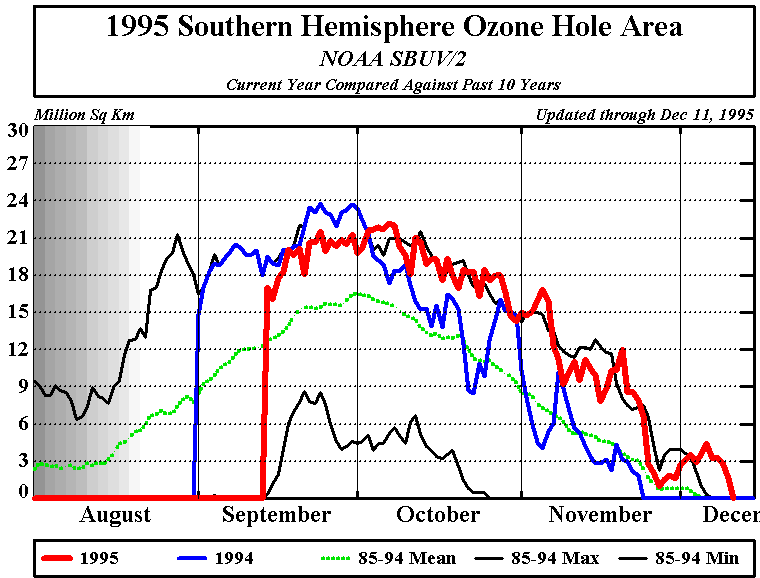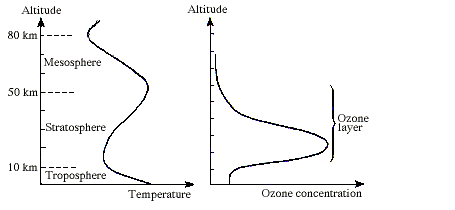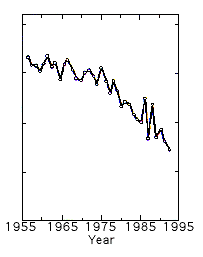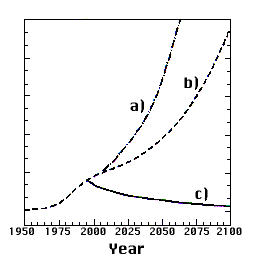|
The Ozone Hole 1995

WMO Antarctic Ozone Summary for 1995
Remarks
An important source of column ozone measurements from space is the Total Ozone
Mapping Spectrometer (TOMS), which when combined with measurements from NOAA's
TIROS Operational Vertical Sounder (TOVS) and ground-based measurements results
in highly accurate images with complete global coverage. Unfortunately, TOMS
data were not available during the 1995 ozone hole period therefore the
resulting ozone analysis for 1995 is somewhat less comprehensive.
Meteorological conditions
While the minimum temperatures between mid September and November were
somewhat lower than in the previous decade, the area sufficiently low to produce
PSCs was very similar to recent years. However, in October the PSC area was
somewhat larger than usual and in general PSC temperatures continued longer than
any year since 1987. From June to mid July the vortex area was smaller than
usual, particularly on the lower levels where the area remained quite small
until the end of October. In November the vortex area remained nearly constant
rather than the usual decrease observed during this period.
Ozone observations
This year the maximum area of the ozone hole was about 23 million km2,
practically identical to 1992 and 1994, and again the largest on record.
Furthermore, the monthly averages of October and November were the greatest on
record. The ozone hole dissipated in early December, similar to the long lasting
ozone holes of 1987, 1990, 1992 and 1993, and reflects the continued strength of
the vortex in November. In early October there was a large area with column
ozone values up to 60% below pre-ozone hole norms. The maximum area with ozone
values more than 50% below pre-ozone hole norms was 10 million km2,
somewhat below the maximum level of 1994 (12 million km2).
Nevertheless, the area in 1995 was at least twice as great as all other years.
Some ground stations measured their lowest daily ozone values ever, with South
Pole measuring column ozone nearly 70% below pre-ozone hole norms (85 DU). This
remains the lowest ozone value ever observed in Antarctica as of 2002. The ozone
hole shape through late October was rather circular but later became more
elongated.
Conditions over the populated regions
Until mid October the southern tip of South America experienced ozone values
up to 20% below norms several times, and Ushuaia measured ozone hole values for
two days in mid October. During November, minimum column ozone values observed
in this region were 30% below pre-ozone hole norms. Over New Zealand and
southern Australia nearly normal ozone values were observed during the entire
ozone hole period.
British Antarctic Survey
summary 1995-Preliminary mean
daily ozone values dropped from values of around 280 Dobson Units (DU) at the
beginning of August to around 175 DU at the end of September (50% depletion).
Individual daily values dropped as low as 132 DU. The first week of October saw
a major spring warming event, with a rise in mean total ozone to over 300 DU as
the circumpolar high ozone belt moved across the station. Mean values then fell
back to around 190 DU in mid October before rising again to over 300 DU in a
second warming event at the end of October. Mean values dropped back again to
200 DU in early November before slowly rising to around 315 DU in the final
warming event of the year in mid December. Values slowly declined from the
December peak to around 260 DU at the end of April.
Generally values in the 95/96
season were a little above those reached in 1993 and 1994 during the first half
of the season and below during the second half. The final spring warming was
much later than in either year. Values were significantly below those of the
long term mean throughout the season.
Press Release
11 October 1995
The Royal Swedish Academy of Sciences has decided to award the 1995 Nobel
Prize in Chemistry to
Professor Paul Crutzen, Max-Planck-Institute for Chemistry, Mainz,
Germany (Dutch citizen),
Professor Mario Molina, Department of Earth, Atmospheric and Planetary
Sciences and Department of Chemistry, MIT, Cambridge, MA, USA and
Professor F. Sherwood Rowland, Department of Chemistry, University of
California, Irvine, CA, USA
for their work in atmospheric
chemistry, particularly concerning the formation and decomposition of ozone.
The ozone layer - The Achilles
heel of the biosphere
The atmosphere surrounding the
earth contains small quantities of ozone - a gas with molecules consisting of
three oxygen atoms (O3). If all the ozone in the atmosphere were
compressed to a pressure corresponding to that at the earth's surface, the layer
would be only 3 mm thick. But even though ozone occurs in such small quantities,
it plays an exceptionally fundamental part in life on earth. This is because
ozone, together with ordinary molecular oxygen (O2), is able to
absorb the major part of the sun's ultraviolet radiation and therefore prevent
this dangerous radiation from reaching the surface. Without a protective ozone
layer in the atmosphere, animals and plants could not exist, at least upon land.
It is therefore of the greatest importance to understand the processes that
regulate the atmosphere's ozone content.
Paul Crutzen, Mario
Molina and Sherwood Rowland have all made pioneering contributions to
explaining how ozone is formed and decomposes through chemical processes in the
atmosphere. Most importantly, they have in this way showed how sensitive the
ozone layer is to the influence of anthropogenic emissions of certain compounds.
The thin ozone layer has proved to be an Achilles heel that may be seriously
injured by apparently moderate changes in the composition of the atmosphere. By
explaining the chemical mechanisms that affect the thickness of the ozone layer,
the three researchers have contributed to our salvation from a global
environmental problem that could have catastrophic consequences.
How this knowledge evolved
Ozone is formed in the atmosphere through the splitting of ordinary oxygen
molecules (O2) by ultra-violet radiation from the sun. The oxygen
atoms thereby liberated react with the molecular oxygen according to:
O2+ uv-light -> 2O
O+O2+M -> O3+M
where M is a random air molecule (N2 or O2).
The English physicist Sidney Chapman formulated in 1930 the first photochemical
theory for the formation and decomposition of ozone in the atmosphere. This
theory, which describes how sunlight converts the various forms of oxygen from
one to another, explains why the highest contents of ozone occur in the layer
between 15 and 50 km, termed the ozone layer (Fig. 1). Later measurements,
however, showed appreciable deviations from Chapman's theory. The calculated
ozone contents were considerably higher than the observed ones. Thus, there must
be other chemical reactions contributing to the reduction of the ozone content.
Some years later the Belgian Marcel Nicolet contributed important knowledge of
how the decomposition of ozone was enhanced by the presence of the hydrogen
radicals OH and HO2.
 |
| Fig. 1.
Variation in temperature and ozone concentration up through the
atmosphere |
The scientist to take the next
fundamental step towards a deeper understanding of the chemistry of the ozone
layer was Paul Crutzen. In 1970 he showed that the nitrogen oxides NO and
NO2 react catalytically (without themselves being consumed) with
ozone, thus accelerating the rate of reduction of the ozone content.
NO + O3 -> NO2 + O2
NO2+O -> NO+O2
O3+uv-light -> O2+O
______________________
Net result: 2O3 -> 3O2
These nitrogen oxides are formed in the atmosphere through the decay of the
chemically stable nitrous oxide N2O, which originates from
microbiological transformations at the ground. The connection demonstrated by
Crutzen between microorganisms in the soil and the thickness of the ozone layer
is one of the motives for the recent rapid development of research on global
biogeochemical cycles.
The first threat noted: supersonic aircraft
The power of nitrogen oxides to decompose ozone was also noted early by the
American researcher Harold Johnston, who carried out extensive laboratory
studies of the chemistry of nitrogen compounds. In 1971 he pointed out the
possible threat to the ozone layer that the planned fleet of supersonic aircraft
and supersonic travel (SST) might represent. These aircraft would be capable of
releasing nitrogen oxides right in the middle of the ozone layer at altitudes of
20 km. Crutzen's and Johnston's work gave rise to a very intensive debate among
researchers as well as among technologists and decision-makers. This was also
the start of intensive research into the chemistry of the atmosphere which has
made great progress during the past several years. (The subsequent cancellation
of plans for a large SST fleet had other reasons than the environmental risks
they involved.)
Spray cans and refrigerators damage the ozone layer
The next leap in our knowledge of ozone chemistry was in 1974, when Mario
Molina and Sherwood Rowland published their widely noted Nature
article on the threat to the ozone layer from chlorofluorocarbon (CFC) gases -
"freons" - used in spray bottles, as the cooling medium in refrigerators and
elsewhere and plastic foams. Molina and Rowland based their conclusions on two
important contributions by other researchers:
- James Lovelock (England) had recently developed a highly sensitive device of
measuring extremely low organic gas contents in the atmosphere, the electron
capture detector. Using this he could now demonstrate that the exclusively
man-made, chemically inert, CFC gases had already spread globally throughout the
atmosphere.
- Richard Stolarski and Ralph Cicerone (USA) had shown that free chlorine atoms
in the atmosphere can decompose ozone catalytically in similar ways as nitrogen
oxides do.
Molina and Rowland realised that the chemically inert CFC could gradually be
transported up to the ozone layer, there to be met by such intensive
ultra-violet light that they would be separated into their constituents, notably
chlorine atoms. They calculated that if human use of CFC gases was to continue
at an unaltered rate the ozone layer would be depleted by many percent after
some decades. Their prediction created an enormous attention. For the CFC gases
were used in many technical processes and their very chemical stability and
non-toxicity were thought to render them environmentally ideal. Many were
critical of Molina's and Rowland's calculations but yet more were seriously
concerned by the possibility of a depleted ozone layer. Today we know that they
were right in all essentials. It was to turn out that they had even
underestimated the risk.
Ozone content over Antarctica
Molina's and Rowland's report led to certain restrictions on CFC release
during the late 1970s and early 1980s. Not until 1985, when the real shock came,
was there any real urgency in the international negotiations on release
restrictions. Then the Englishman Joseph Farman and his colleagues noted a
drastic depletion of the ozone layer over the Antarctic, the "ozone hole" (Fig.
2). The depletion was, at least periodically, far greater than expected from
earlier calculations of the CFC effect. The debate among researchers now
intensified. Was this a natural climatic variation or was it chemical
decomposition brought about by mankind? Thanks to pioneering research by many
researchers, among them Crutzen, Molina and Rowland, as well as Susan Solomon
and James Anderson, both from the USA, the picture has now cleared. The
depletion is caused chiefly by ozone reacting chemically with chlorine and
bromine from industrially manufactured gases.
|

|
|
Fig 2. Thickness of the ozone layer (mean monthly value for October)
over Halley Bay, Antarctica. Note the drastic depletion since the end of
the 1970s. |
The surprisingly rapid depletion
of the ozone layer over Antarctica could not be explained by transport processes
or by gas phase chemical reactions. An alternative mechanism must exist which
could accelerate the decomposition of ozone. Crutzen and colleagues identified
this mechanism as chemical reactions on the surface of cloud particles in the
stratosphere. Thus, the Antarctic ozone depletion appears to be connected with
the extremely low prevailing temperatures, which lead to condensation of water
and nitric acid to form "polar stratospheric clouds" (PSCs). The
ozone-decomposing chemical reactions are greatly reinforced by the presence of
cloud particles. This understanding has led to an exciting new branch of
atmospheric chemistry: "heterogeneous" chemical reactions on particle surfaces.
The ozone layer and the climate
The ozone problem also has interesting connections with the issue of how
mankind is affecting the climate. Ozone, like carbon dioxide and methane, is a
greenhouse gas that contributes to high temperatures at the surface of the
earth. (CFC gases have a similar effect). Model calculations have shown that the
climate is specially sensitive to changes in the ozone content in the lower
layers, the troposphere. Here the ozone content has increased markedly during
the past century, chiefly because of the release of nitric oxide, carbon
monoxide and gaseous hydrocarbons from vehicles and industrial processes and
from the combustion of biomass in the tropics. The elevated ozone content in
lower atmospheric layers is itself an environmental problem for the damage it
can cause to crops and human health. Paul Crutzen has been the world's leading
researcher in mapping the chemical mechanisms that determine the ozone content
at these levels.
What can we expect in the future?
Thanks to our good scientific understanding of the ozone problem - and very
largely to Crutzen, Molina and Rowland - it has been possible to make
far-reaching decisions on prohibiting the release of gases that destroy ozone. A
protocol on the protection of the ozone layer was negotiated under the auspices
of the United Nations and signed in Montreal, Canada, in 1987. Under the latest
tightening-up of the Montreal Protocol, the most dangerous gases will be totally
banned from 1996 (developing countries have a few years' grace to introduce
substitutes that do not harm the ozone layer). Since it takes some time for the
ozone-destroying gases to reach the ozone layer we must expect the depletion,
not only over Antarctica but also over parts of the Northern Hemisphere, to
worsen for some years to come. Given compliance with the prohibitions, the ozone
layer should gradually begin to heal after the turn of the century (Fig. 3). Yet
it will take at least 100 years before it has fully recovered.
 |
|
Fig 3.
Change in the chlorine content in the stratosphere up to the present and
three different future scenarios: a) Without restrictions on release, b)
Limitations according to the original Montreal Protocol of 1987 c) The
release limitations now internationally agreed. (Chlorine content is a
measure of the magnitude of ozone depletion.)
|
|







